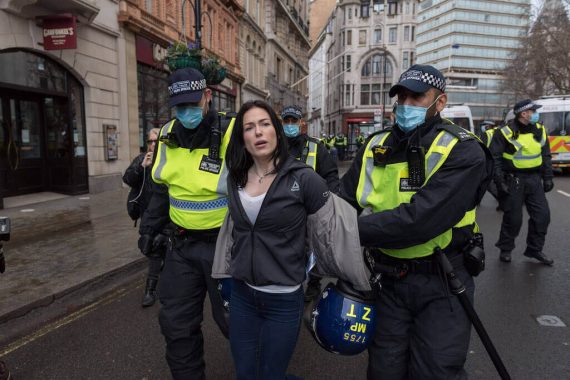Recently hashtag #Covid20 become a trending topic in social media, with people raising concerns over the new variant of SARS-CoV-2 virus, which seems to have appeared in London in Mid-September.
Many nations, including Turkey, barred the flights from and to the U.K. The new variant suddenly became the focus of the Coronavirus debate and the pandemic’s future. In this article, I will summarize what we know about this new variant and what it can cause.
As they replicate, viruses develop small changes in their genetic code known as mutations. While not all mutations are useful to the virus or change its characteristics, they sometimes lead to considerable changes.
By tracing these changes, one can gain insight into how the virus spreads. The U.K., which holds %45 of all coronavirus sequences done globally according to the GISAID database, is the leading country in this genomic epidemiology approach. Hence it is no surprise that this new variant labeled B.1.17 is spotted there in the U.K.
Although the SARS-CoV-2 virus is not a fast mutating virus, several thousand mutations have been observed so far. B.1.17 is interesting because it has 23 mutations, of which 17 change the virus’s proteins, which can directly affect its behavior.
The first, possibly, confirmed change is the increased transmission of the virus. Scientists in the U.K. noticed that this variant spreads more quickly in England as it is more commonly observed in infected patients. Early estimations suggest that this variant transmits %50-70 faster.
This rate explains why there is a spike in the COVID-19 cases in England. At this point, I need to warn the reader that this may turn out to be a false alarm.
What does this mean? If the virus is really more contagious and spreads to the world, lockdowns will become longer and more severe.
B.1.17 may have become more common in England not because it is spreading faster but because it was lucky. If the virus is spread by superspreaders or at a densely populated area, it might have become more common without being more contagious. Laboratory experiments, which have already started, will provide a definite answer to this question.
We should note that another variant that appeared in South Africa known as 501.V2, which has the same particular mutation as B.1.17 (mutation N501Y) seems to be spreading at a more rapid pace. So we need to be prepared for the faster spreading virus.
What does this mean? If the virus is really more contagious and spreads to the world, lockdowns will become longer and more severe. %50 faster transmission is a considerable number; therefore, the pressure on the hospitals will increase.
To flatten the curve, we will keep the relaxed lockdown periods shorter. It will also make the number of vaccinated people more critical. It is currently estimated that to get herd immunity and return to normal %60-70 of the population need to be vaccinated.
But if this variant becomes dominant and, as feared, is spreading faster, then the number of vaccinated people should be increased. Hence vaccination will become even more critical.
Another possible change implied by the data collected so far is that this new variant may be more prone to infect children. Again we need to wait for more data to be sure. Typically children are far less likely to get infected and therefore pass the virus compared to adults. This is what makes possible the operation of some primary schools in many countries. But this variant may make children equally susceptible to infection.
Given this possibility, governments should get ready to have at least one more online education semester, even at the primary school level. Although child deaths are not expected to increase rapidly, an increase in their infection may lead to more child deaths. The emotional nature of these deaths may put more pressure on governments for lockdowns.
Again we should note that it was reported that the South African variant is affecting younger people more when compared to other strains. Thus, it will not be surprising if B.1.17 affects young people more.
Another critical question is the impact of the mutations on the mortality rate and symptoms of the COVID-19. There is no evidence suggesting that this variant increases the mortality rate or causes more severe disease. However, we should be cautious at this point. South African variant 501.V2 has worsened symptoms of the disease.
Doctors observed that people infected with 501.V2 have bigger viral loads, i.e., higher concentration in their upper respiratory tract. This is expected to lead to more severe cases of COVID-19. In fact, in South Africa, it has been reported that young adults with no underlying health conditions are getting severely ill. Again we need to wait for more data to be sure.
At this stage of uncertainty, the companies’ claim about the effectiveness of the vaccine may be based more on business strategy rather than actual science. mRNA vaccines, such as the ones developed by Moderna and Pfizer/BioNTech, create the spikes of the virus in our body.
What about the effect of B.1.17 on the vaccines, which will be shortly used to boost immunity in the population. Vaccine firms and most experts claim they do not think that new strain will impact the immunity developed by the vaccine.
At this stage of uncertainty, the companies’ claim about the effectiveness of the vaccine may be based more on business strategy rather than actual science. mRNA vaccines, such as the ones developed by Moderna and Pfizer/BioNTech, create the spikes of the virus in our body.
As a result, the antibodies developed by our body with the help of these vaccines target the virus’s spikes. By sticking to the spikes, antibodies prevent the virus from entering the cells, hence causing the illness.
However, we need to note that 8 of the mutations which resulted in B.1.17 changed the proteins forming the spike. This may result in a change in spikes shape in a way that will result in failure of the antibodies sticking to it.
Did this change happen? Probably not, but we do not know for sure. We should note that B.1.17 faster infection rate may result from a failure of gained immunity by other ordinary variants. Hence, people got infected with this variant a second time. We need to have more data to draw a conclusion.
Now let us look at the bigger picture. What can we learn from the emergence of this and other variants of the SARS-CoV-2? First, we need to realize that new variants of the virus that are deadlier or resist the vaccine resistance are possible. Governments should develop policies aiming at minimizing the chance of the emergence of dangerous variants of the virus, which seems to be lacking at the moment. The most effective way is, of course, lockdowns, quarantines, and social distancing.
As more people get infected, the chances of the emergence of such dangerous variants will increase. This is another reason why herd immunity was a bad idea. Second, these viruses usually emerge in animals. Infected people should distance themselves from animals, and governments should implement policies that minimize contact with the animals. Let me remind the reader that the dangerous variant Cluster 5 emerged in minks in Denmark.
Recommended
The second lesson is that there may be some variants of the virus, perhaps undiscovered for the moment or did not yet emerge. We have to be aware of this possibility and prepara for it. There is now a “cold war” of vaccines in the world.
Many countries invest in a single vaccine. This strategy is very bad because if these particular vaccines fail in some variant, all the population will suddenly lose its immunity. It is better to invest in multiple different vaccine technologies to increase the emerging herd immunity’s versatility, making it more robust against the new variants.
The third lesson is that there is still no global consciousness to act fast in the time of the emergence of new viruses. While many countries barred the flights from and to the U.K., the variant already spread to many countries such as Denmark, Belgium, Netherlands, Australia, and Italy.
The idea of barring flights is futile in the long run. Early detection of a new variant is very important in stopping its spread, so genetic epidemiology should be practiced widely. Developed countries should help the developing countries to acquire this technology.

VIDEO: What we know so far about the new strain of coronavirus discovered in the UK | ITV News







